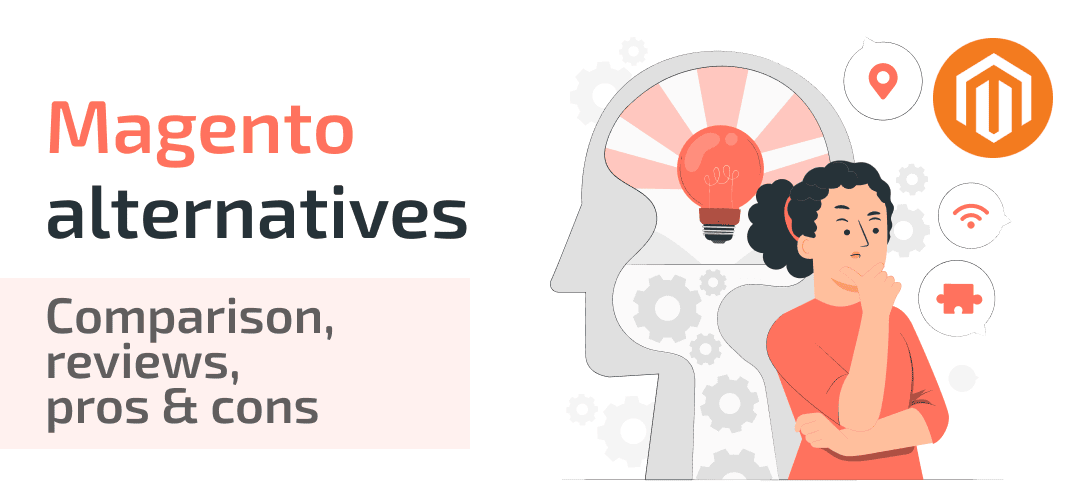
Magento has been around for more than 15 years (since 2008), and currently unites a community of 250,000 users and empowers thousands of online stores worldwide.
Initially launched as an open-source project, it gradually evolved into a prominent player in the eCommerce arena. The software offers a wide range of selling functions and robust management features to facilitate online sales for medium- and large-sized businesses.
With high customization levels and hassle-free scalability, it’s possible to create whatever component your eCommerce website needs and integrate it into the basic architecture. Sounds too good to be true, right? And there’s an obvious question to be asked. If it’s so damn good and popular, why are developers and merchants seeking a Magento alternative?
Our content team browsed through forums and developer blogs in the search for an answer, and summarized the facts and opinions found. The ultimate goal was to understand the reasons for migration and examine alternatives that provide similar functions and yet redeem known drawbacks. Keep on reading this post and you’ll learn the best candidates for Magento’s crown.
What’s the difference between Magento and Adobe Commerce?
Before choosing a suitable alternative for your eCommerce business, we need to analyze Magento’s functionality, and distinguish between Magento Open Source and Adobe Commerce that often get confused.
The first version of Magento (known as Magento Community Edition) was released in March 2008. Its open-source model allowed businesses to create and manage their online stores with a high degree of control over design, functionality, and third-party extensions.
In 2018, Adobe Commerce was introduced on the basis of the Magento 2 architecture and Adobe's marketing and analytics tools. The software incorporated additional features and capabilities tailored for enterprise-level businesses. One of the notable aspects is that it's offered in both a cloud-based version (Adobe Commerce Cloud) and a self-hosted version (Adobe Commerce on-premises).
However, Adobe Commerce hasn’t completely replaced Magento Open Source. These two versions are not interchangeable and co-exist in today’s market as similar options to choose from. This means that they offer slightly different functionalities under various license conditions.
| Magento Open Source | Adobe Commerce | |
|---|---|---|
| Price | Free version, released once in 1-1,5 years | License fee, starting from $22,000 per year |
| Target audience | Suitable for start-ups and small businesses | Designed for enterprise-level businesses |
| Toolkit | Basic eCommerce features, including:
|
The default features available, plus:
|
| Support | No technical support, only dedicated community to help | 24/7 technical support, dedicated account manager |
Understanding these differences and their impact on online businesses, companies can not only choose between these two versions but also find eCommerce platforms like Magento but more easy to use, cheaper, more flexible, etc. This brings us to the main point – not every company settles down with Magento and searches for alternatives.
Why businesses may seek a Magento alternative?
Despite its popularity, something is rotten in the state of Magento. Actually, there are several reasons why businesses might seek alternatives to Magento.
These reasons range from cost considerations to technological limitations and shifting market dynamics. Here are some key factors driving businesses to explore other options:
Cost of ownership
While Magento offers a powerful suite of features free of charge, it is often associated with high implementation costs. The initial setup, customization, and ongoing development can demand significant financial resources. Sometimes it seems easier to launch a Magento website from scratch than further develop and maintain it.
What’s more, some valuable features (like B2B support) are not available in the free version, which makes a switch to the paid edition almost inevitable or forces companies to invest into premium extensions. Obviously, both solutions entail additional expenses.
In the case of Adobe Commerce, the pricing model depends on a certain turnover. Subscription cost per year starts at $20,000 (from $22,000 to $125,000/year for the self-hosted edition; from $40,000 to $190,000/year for the cloud edition), and that’s for a company with less than $1M average gross sales revenue. If your revenue is low, you will still have to pay the minimum license fee.
Time to market
The ability to quickly launch new products or adapt to market trends is crucial for the sphere of eCommerce. And Magento is often criticized for complexity, over-engineered code, speed issues and resource needs.
Magento’s complexity can sometimes lead to longer development cycles, delaying time to market for new features or store launches. Additionally, this complexity requires skilled developers, which further contributes to operational expenses. Smaller businesses or those with limited budgets may find these costs prohibitive.
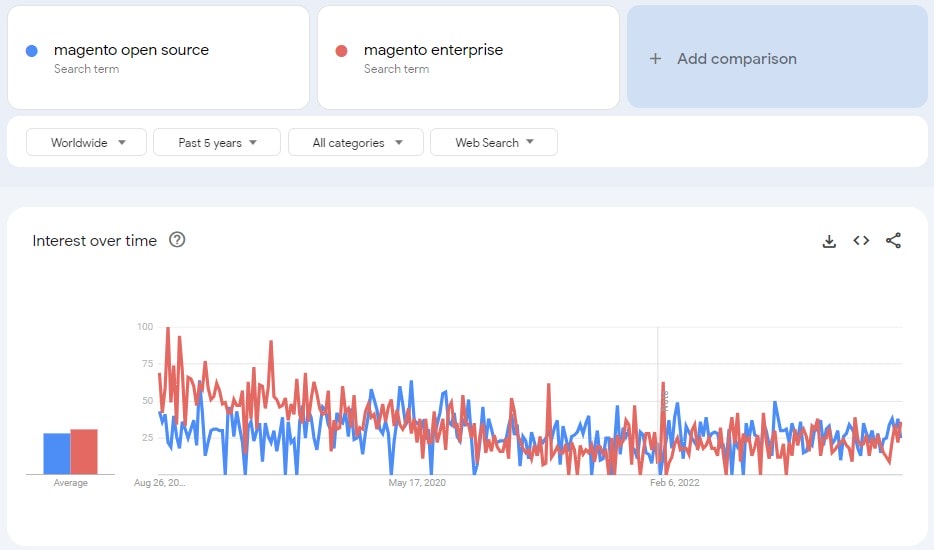
Dynamics of interest rates to Magento from 2018 to 2023, according to Google Trends
Scalability
As businesses grow, their e-commerce platforms need to handle increased traffic and transaction loads. While Magento is scalable, achieving optimal performance at scale can be challenging. It might require intricate server configurations, caching mechanisms, and performance optimizations.
Since Magento Open Source is primarily a B2C platform, rapidly growing businesses can outgrow the platform because of its functionality limitations. For example, the free version only supports a single database system, which means your website could perform slower if you have multiple websites and storefronts. It also has limited multilingual functionality, so merchants have to configure additional extensions and language packs to sell products or services internationally.
Security
Another important aspect is that Magento Open Source doesn’t meet PCI Compliance requirements. Consequently, you can either integrate a third-party payment method that redirects customers to another website to complete the transaction (for example, PayPal and Authorize.net) or use a payment method compatible with PCI SaaS (CRE Secure).
No matter what protection method you choose, it would require additional time for customization and more money to hire a development team.
As you can see, Magento (whatever version you pick) isn’t a silver bullet and has a number of considerable drawbacks that may scare you away. If you’re adamant about switching the platform or drifting towards alternatives, check out our extensive list below.
Top 10 Magento alternatives: pros & cons
To give you a better understanding of the eCommerce options available on today’s market, we decided to divide all candidates into several groups, taking into account the type of software. Thus, you can choose from three big categories - open-source eCommerce platforms, SaaS solutions and cloud-based services.
Note: The platforms below are not ranked but given in a random order. We strongly recommend that you test (or at least request a demo) any of these eCommerce software before making your final decision.
Open-source alternatives for businesses of any size
This group is the closest to the original Magento and its distribution model. This means that these eCommerce platforms are free and provide a plenty of customization options.
Considering the undying popularity of this category, we’ve chosen the best open-source eCommerce platforms that have the same pros as Magento but overcome its biggest cons.
nopCommerce

Powered by the latest Microsoft technologies, nopCommerce is probably one of the best Magento alternatives. It’s been around as long as Magento but focuses exclusively on the development of its open-source model. In other words, there is only one version that includes all the eCommerce functionality without any limitations or additional fees. Yep, this eCommerce platform remains absolutely free (including multi-vendor and multi-store support).
In addition to a configurable shopping cart, the platform provides powerful sales and marketing options suitable for B2B, B2C, B2G, B2B2C, etc., dropshipping, multi-currency and multi-language, advanced wholesale tools (unlimited product quantity, multi-warehouse, tier-pricing and “call for price”) and many other out-of-the-box functions.
To serve large and enterprise-level webshops, the platform meets all PCI and GDPR compliance requirements, supports external authentication, web farms and asynchronous methods. To interact with CMS, ERPs, PIMs, POS, and custom front-end solutions, nopCommerce utilizes the Web API plugin and ready-to-use mobile app (both developed by the core team).
All in all, the flexible architecture and source code available helps the nopCommerce platform to adhere to business needs and legal requirements adopted in various countries.
Pros
- nopCommerce is the only open-source eCommerce solution with multi-vendor and multi-store features available without any additional fees
- Enterprise-level functionality comes out-of-the-box (CRM, ERP and other third-party integrations, wholesale and omnichannel features, dynamic pricing, automatic tax calculation, etc.)
- Advanced SEO features, including user-friendly URLs, canonicalization, sitemap, breadcrumbs, website analytics
- Extensive training materials, including documentation, certification and online courses
- Pluggable architecture with 1500+ plugins, integrations, themes and language packs
Cons
- Few professional designer themes in contrast to Magento templates on ThemeForest.net
- CMS management tools are too generic for rich content pages.
Read more: nopCommerce vs Magento or nopCommerce vs Magento Open Source by G2.
WooCommerce
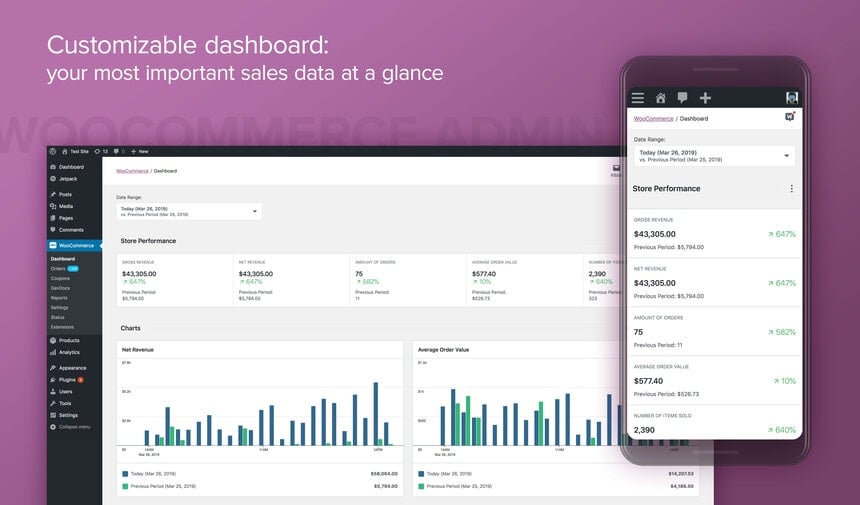
WooCommerce isn’t an eCommerce platform in the real sense of this word, but an open-source plugin for WordPress. However, this fact takes nothing away from its easy-to-use interface, robust CMS tools and eCommerce functionality.
Unlike Magento, WooCommerce is much easier to set up for small and mid-sized businesses. Even merchants with no technical expertise can install the plugin on their website and configure it to specific requirements – a WooCommerce setup wizard will assist them in every step. After installing the shopping cart plugin, the administrator can manage all settings, add-ons, orders, reports, inventory, linked products, shipping, and categories.
If the default WooCommerce functionality isn’t enough, it can be extended with lots of dedicated extensions for such eCommerce-related processes like shipping, payment gateways, tax calculation, and designer templates to modify the front-end of your website. All this makes WooCommerce a popular solution, converting WordPress websites into a functioning online store.
Pros
- User-friendly and intuitive interface similar to that of WordPress
- Supports multi-channel sales through integrations with Amazon, eBay, and Walmart
- Powerful blogging tools built on the CMS
- One of the largest plugin markets for open-source platforms
Cons
- Not a universal solution as it is compatible only with WordPress-powered websites
- Since there are so many plugins and add-ons developed by different teams worldwide, they can conflict with each other
- Due to the restrictions of the WordPress architecture, it isn’t scalable enough for big eCommerce websites and requires advanced-level plugins (for example, to unlock B2B functionality).
Read more: nopCommerce vs WooCommerce: differences in functionality and performance.
OpenCart
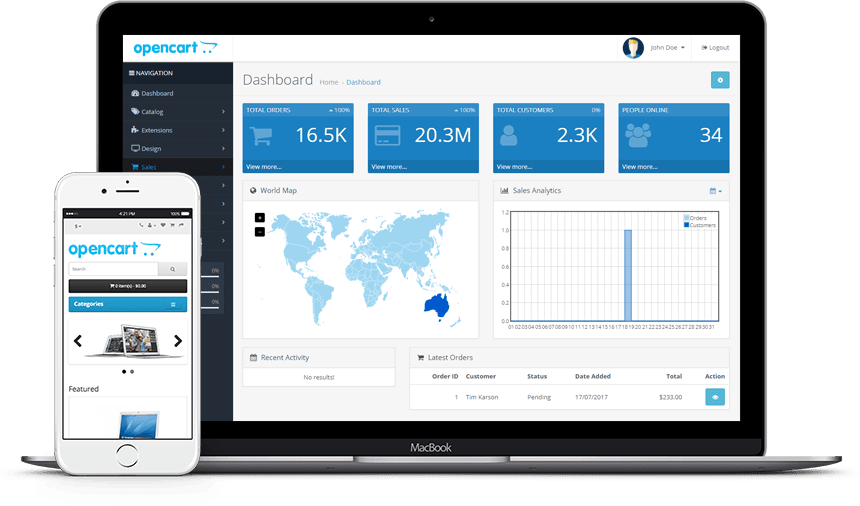
OpenCart is another open-source eCommerce platform that can become a Magento substitution for financially challenged or emerging businesses. Of course, Adobe’s software is more robust but OpenCart offers a more straightforward and minimalistic interface, and a simpler coding structure and installation process that helps set up an online store with minimum efforts.
Having such built-in features like support for multiple languages, product ratings and reviews, downloadable products, recurring payments, and guest checkout, OpenCart can easily empower an eCommerce website even before adding third-party apps and modules for customization.
Pros
- Lightweight and fast eCommerce platform
- Easy migration from Magento since both platforms are based on the PHP code
- Over 13000 modules and 2,700 design themes to add to your website (many of them are completely free to use)
Cons
- The platform no longer receive updates on a regular basis
- Slow checkout
- Limited SEO and marketing features.
Prestashop

PrestaShop is yet another Magento similar product, coming with the source code and providing ample opportunities for customization. Unlike OpenCart, it’s an evolving platform that is regularly updated and extended with new themes and plugins, so you’re hardly to be left with legacy software at your hands and try to update it yourself.
The toolkit includes many eCommerce, marketing and analytical features by default: downloadable and physical products, free shipping, email automation, cross-selling, one-page checkout, etc. If this functionality isn’t enough, there are thousands of modules and plugins to integrate new features (however, keep in mind that some extras come at an additional cost).
Just as other open-source eCommerce platforms, PrestaShop requires at least some technical knowledge, but those who lack expertise can still benefit from using a fully managed service. Thus, merchants are provided with both hosting and maintenance and don’t have to worry about a custom installation. Indeed, this option isn’t for hard-boiled eCommercers but it works best for people without coding knowledge.
Pros
- A drag-and-drop functionality to simplify the management of product images and descriptions
- Robust CRM (different user groups, automated emails, etc.)
- Flexible product configuration and structured workflow for content generation
- Doesn’t require extensive server resources for effective functioning
Cons
- Has some scalability issues so it isn’t the best option for businesses with a wide range of products
- Prestashop upgrading to newer versions is a bit challenging and may require full-fledged migration due to some themes or modules no longer compatible
- Not enough online documentation and difficult-to-understand user guides.
Drupal

Structurally, Drupal Commerce is close to WooCommerce and is an eCommerce platform based on Drupal, a powerful and popular content management system. As a result, it has all the advantages of a CMS system and disadvantages of a pluggable eCommerce architecture.
With Drupal Commerce, users can choose from a variety of mobile-responsive themes and customize their design to better represent a particular online store. Together with several shipping and payment methods, Drupal Commerce keeps an organized record of orders, receipts, and invoices. Based on the content management system, it provides a full administration system with a checkout form and multi-currency support.
Built with customization in mind, Drupal Commerce also helps in the optimization of eCommerce websites for search engines. Calculating the final cost of running a website on Drupal Commerce is difficult as it depends on the scale of the store and the features added.
Pros
- Multi-store support to set up individual online stores with different currencies, products, and checkout processes
- Can adopt a headless architecture thanks to smooth integration with GraphQ
- Strong security features
Cons
- High system demands
- It has a bit of a learning curve and is hard to master by less experienced developers.
Read more: nopCommerce vs Drupal Commerce: Which one is most suitable for your business?
SaaS alternatives for small & mid-sized businesses
Although Adobe Commerce Cloud isn’t a full-on SaaS solution, it embraces the ease of use and powerful functionality common to this category. Unlike open-source options, this group of Magento alternatives are not free and can require considerable funds for launching and maintenance (often depending on the company’s revenue).
This means that you can forget about paying once and for all, but the starting price can be more suitable for solo entrepreneurs and small businesses. On the other hand, these eCommerce platforms don’t require solid technical skills and can be set up by digital newbies.
Shopify

Shopify is one of the most popular SaaS eCommerce applications with over 60,000+ add-ons, hundreds of free and premium themes available on its marketplace. For a fixed subscription (the basic plan starts from $9/mo), users get all the essential eCommerce features in different tiers. For example, the cheapest version imposes limitations on the number or products you can sell, but they can be uplifted if you switch to a different plan.
When it comes to payment gateways, there are PCI-compliant built-in options like Shopify Payments and Shopify Pay to ensure safe payments for customers. However, if you want to use any third-party payment gateways, Shopify will charge you for that.
As for business growth and scalability, Shopify offers numerous options and editions to meet any requirements. The only downside is that the more additional apps or features you integrate, the more difficult it becomes to run an eCommerce website. This means that your business should scale keeping in mind the restrictions and higher costs of the senior version.
Pros
- No need to worry about hosting, domain name, SSL encryption, etc. since everything is covered in the subscription plan
- Unlimited bandwidth and online storage to support a large product catalog
- Detailed analytics and reporting tools included to track sales, customer behavior, etc.
- Point of sale functionality, and a built-in automatic tax calculator at check-out
- Built-in fraud prevention to provide customers with a safe shopping experience
- Can easily integrate with additional sales channels like Amazon, eBay or Instagram
Cons
- Less room for customization in comparison with open-source softwares
- Requires monthly payments, additional investments in apps outside of the box and transaction fees for using third-party payment gateways (the total cost of ownership grows together with the development of your business).
WiX eCommerce

WiX eCommerce is currently gaining momentum in the market thanks to its feature-rich toolkit and AI-powered functions. Instead of a dedicated eCommerce platform, it is more like a website builder which enables the creation of online stores via its WiX Stores feature.
It offers an AI-powered drag-and-drop interface that gives smart alerts on how the edits made affect the overall website design. If you’re just starting an eCommerce business and don’t have a brand yet, WiX eCommerce has a logo maker and business name generator built in. There are also traditional store management tools like worldwide shipping, abandoned cart recovery, and multi-channel selling features.
For the purposes of extending the default functionality, there are about 250+ add-ons and more than 500 industry-specific templates. To get started, WiX eCommerce offers a free plan but allows store owners to switch to premium plans later on (starting from $23/mo).
Pros
- Plenty of easy-to-use design tools to smoothly edit any storefront which require nearly zero tech experience
- A “buy now, pay later” feature to collect payments after the product is delivered
- Support for multiple sales channels, including Instagram, Facebook, and Amazon
- SSL certification, secure payment options, and compliance with PCI DSS standards out-of-the-box
Cons
- While WiX is suitable for small to medium-sized online stores, it may have limitations in terms of scalability for larger eCommerce businesses with complex needs
- Poor stock management as the platform doesn’t inform when stock levels are low
- Migrating away from WiX to another platform can be challenging, as Wix doesn't allow you to export your website easily.
Volusion

Being one of the oldest players in the eCommerce game, Volusion is a compelling Magento eCommerce alternative, offering a robust set of features tailored for the needs of online businesses. It comprises a rich content editor, a navigation editor, search functionality for customers, product page builder, inventory management system, SEO tools, and responsive themes.
From tracking customer history to managing contacts, the customer dashboard makes it easy. Monitoring these essential metrics is useful for marketing and managing shoppers. Volusion also allows to draw visitors to the website through SEO, social media sharing, and marketplace integrations (Amazon and eBay).
The first tier is only $26/month, and it includes 1 GB, up to 100 products, and online support. This amount can be enough for small businesses but larger companies will have to pay more in order to unlock the necessary functionality.
Pros
- Easy reporting to get insights on purchases, abandoned and live carts, product and category views, CRM tickets, etc.
- No transaction fees for every product you sell
- Top-notch designer themes
- 14-day free trial
Cons
- Impossible to add a blog to an eCommerce website as there’s no CMS
- SSL certificate is not included
- Cannot sell digital products
- Traffic-dependent pricing so it’s hard to predict expenses.
Software suite alternatives for enterprises
Cloud-based eCommerce suites are the most costly Magento alternatives that provide large businesses with a comprehensive set of tools and services to create, manage, and operate enterprise-level online stores. Simply put, these combine marketing, accounting, team productivity, enablement and many other instruments in one platform.
Naturally, these options would be too expensive and difficult to use for small and mid-sized businesses so their target customers are likely to be corporations.
Salesforce Commerce Cloud
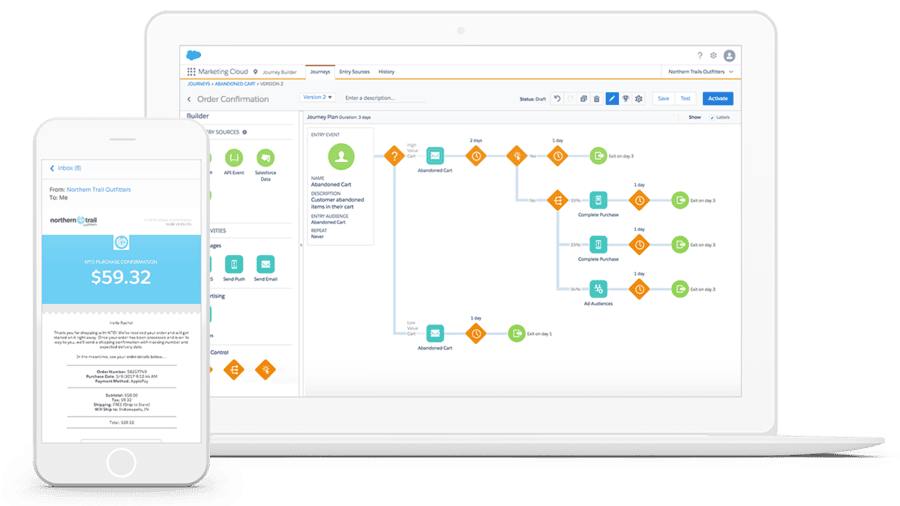
Salesforce Commerce Cloud is engineered to meet the demands of large enterprises and high-growth businesses. Like Adobe Commerce Cloud, it operates on a cloud-based architecture. This means an eCommerce website is hosted on powerful and secure cloud servers, eliminating the need to manage and maintain on-premises infrastructure.
Salesforce leverages AI and machine learning to offer advanced personalization and predictive analytics. This helps businesses deliver tailored product recommendations and marketing strategies, enhancing the overall customer experience and boosting sales.
Salesforce Commerce Cloud also provides a seamless shopping experience across various channels, including web, mobile, social media, and in-store. It supports both B2B and B2C commerce, making it a versatile solution for different business models.
In comparison with Magento, it allows to access complex product data and strong native merchandising features. However, this functionality comes at a greater price – the platform charges $4 per order for a B2B eCommerce store, with 1% gross merchandise value for a basic B2C ecommerce store.
Pros
- Marketing and merchandising tools for campaigns management, real-time reports and dashboards
- Customer segmentation and segment specific pricing
- Native targeting and A/B testing
- Multi-site management to sell on multiple sites
Cons
- Resource-intensive in terms of server resources and infrastructure, potentially leading to higher hosting costs
- Vendor lock-in: migration can be challenging due to the platform’s proprietary nature.
Oracle NetSuite

Oracle NetSuite is a cloud-based enterprise resource planning and business management suite that encompasses various business functions, including eCommerce. While Magento is a specialized open-source eCommerce platform, Oracle NetSuite offers a broader range to manage and streamline various aspects of a business.
Oracle NetSuite’s scalability extends beyond eCommerce, supporting not only online stores but also complex supply chains, multi-location inventory management, etc. The platform is also renowned for its ability to integrate and manage multiple business aspects, including financials, inventory, CRM, marketing, and eCommerce. This comprehensive approach allows businesses to streamline operations, reduce data silos, and gain real-time insights.
However, the cost structure of Oracle NetSuite and Magento differs significantly. Oracle NetSuite typically involves a higher upfront investment due to its extensive capabilities.
Pros
- Comprehensive business management, including financials, inventory management, CRM and eCommerce
- Supports over 190 currencies, exchange rates and payment options for international business operations
- Industry-specific editions
- Automatic updates
- Real-time reporting and analytics
Cons
- Complex integration challenges with existing systems and third-party applications
- High costs, including licensing fees, implementation costs, and ongoing subscription fees
- Cumbersome data migration.
Factors to consider before migrating away from Magento
If you’ve looked through this list of Magento alternatives and found a suitable option, it’s time to prepare for replatforming. While the process isn’t something new, it’s still challenging for both developers and SEO managers.
To avoid headaches and additional costs, we recommend to consider the following factors:
- Current business needs. Assess your eCommerce needs and whether Magento still aligns with them. Consider the size of your product catalog, your target audience, and your sales channels. Ensure that the new platform can meet these requirements.
- Total cost of ownership. Migrating to a new platform includes not only the cost of the new software but also migration expenses, development costs, and potential subscription fees. Do the calculations to make sure you benefit from the migration.
- Data migration. Migrating data to a new platform can be complex, especially if you have a large customer database, product catalog, and order history. Follow this eCommerce migration checklist to avoid disruptions.
- Customization and integration. Review the level of customization and integration your business relies on. Magento’s flexibility and extensive plugin ecosystem may have led to a highly customized setup. Ensure that the chosen alternative can replicate or accommodate these customizations.
- SEO impact. Consider the potential impact on your search engine rankings. A poorly executed migration can lead to SEO issues, resulting in a loss of organic traffic and revenue. Ensure that the new platform supports SEO best practices.
- Downtime and transition period. Plan for potential downtime during the migration process and the transition period afterward. Communicate any changes to your customers and ensure they have a smooth shopping experience during the switch.
- Future scalability. It’s better to think long-term and consider not only your current needs but also your business’s future growth.
So, if you’re adamant about migrating away from Magento, think over your business needs, budget, and long-term goals. While there are compelling Magento alternatives available, it's crucial to understand how each platform aligns with unique company’s requirements.
Wrapping Up
Magento has long been a powerhouse, but it's not the only player in the game. Whether you’re an aspiring start-up, a flourishing enterprise, or a niche brand, the world of eCommerce offers more options that might align more closely with your business objectives.
However, the choice ultimately hinges on your unique requirements. For example, WooCommerce thrives within the WordPress ecosystem, Shopify offers an accessible and hosted solution, Salesforce Commerce Cloud serves enterprise-level needs, and Oracle NetSuite provides comprehensive business management.
Among these alternatives, nopCommerce emerges as a standout choice. Its open-source nature, feature-rich toolkit, almost unlimited scalability, and cost-effectiveness make it an all-in-one option for businesses of all sizes, and a decent replacement for Magento.
The key lies in making a well-informed choice that positions your online store for success, and nopCommerce proves to be a compelling contender in this quest.